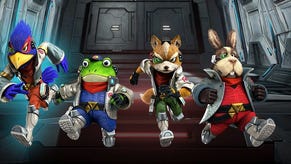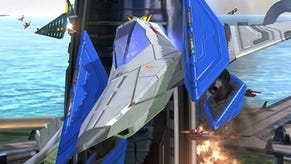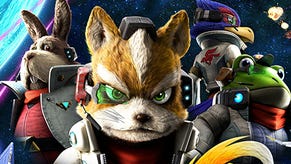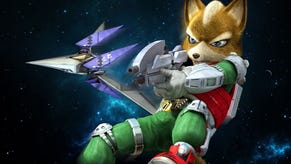Star Fox Zero in Hindsight: The Developers on the Controls, the Decision Not to Include Multiplayer, and the Future of Star Fox
Platinum's Yusuke Hashimoto and Nintendo's Yugo Hayashi elaborate on their approach to Star Fox Zero.
This article first appeared on USgamer, a partner publication of VG247. Some content, such as this article, has been migrated to VG247 for posterity after USgamer's closure - but it has not been edited or further vetted by the VG247 team.
Star Fox Zero has enjoyed an interesting reception since launching back in late April. Though it is only averaging a 69 on Metacritic and has been derided by some long-time fans of the series, it also has its share of vocal supporters. Its legacy will no doubt be complicated.
Shortly after completing my review of Star Fox Zero, I had a chance to speak with Yugo Hayashi and Yusuke Hashimoto, who lead the development of Star Fox Zero on behalf of Nintendo and Platinum respectively. I used the opportunity to pick their brains a number of topics, including how the project came about, the development of the Gyrowing, and whether Nintendo would consider revisiting the series down the line with more traditional controls. Here's what they had to say.

On Platinum's role in developing Star Fox Zero
One of the first things I wanted to confirm was how exactly Platinum and Nintendo ended up splitting the workload on Star Fox Zero. Hashimoto explained, "In terms of what PlatinumGames was in charge of, overall, Mr. Hayashi was involved with planning overall for the game, and then PlatinumGames was in charge of basically all of the visual elements of the game. Character models, animations, background, basically anything visual on the game was something handled by Platinum."
Star Fox Zero began life as a prototype at Nintendo; but when it came to developing a full game, the Star Fox turned to Platinum due to their action game roots. Hayashi added, "We were actually all in the same room, we had people from PlatinumGames working with, in the same room, designers and other folks from there, so it was very tight-knit."
On the in-house reaction to the disappointing E3 2015 demo
Star Fox Zero made its true debut at E3 2015 (the prototype had appeared at E3 2014). Initial reactions were mixed as the press and public struggled to adapt to the new scheme. Hayashi recalled, "Thinking back to that E3, it's obviously an event where there are lots of people around and you get a very short amount of playtime, so it definitely did feel to me then that it probably wasn't the best environment to be presented with a completely new control style. And what's great about an action game is that you have these responsive controls that you master and they become very intuitive and you're able to do all these cool things, so what we want people to get out of this game is being able to get used to these controls, master these controls, feel like they're able to do cool things with them, go for higher scores - really enjoy the arcade action."
"And just to continue on from that, it's precisely that reason that we added the training mode in the eventual full version of the game, because we felt like people would need a lot of time to get used to the controls, to really have them feel good. Another thing that was important with the training mode is that people would be able to try out vehicles before they ever see them in the story mode so that, the first time they show up in the story mode, they're not just completely confused. So, it's definitely something we were cognizant of - the need for people to have a slow warm up to the controls. So the training mode is definitely something that we want people to play before they do play the full version."
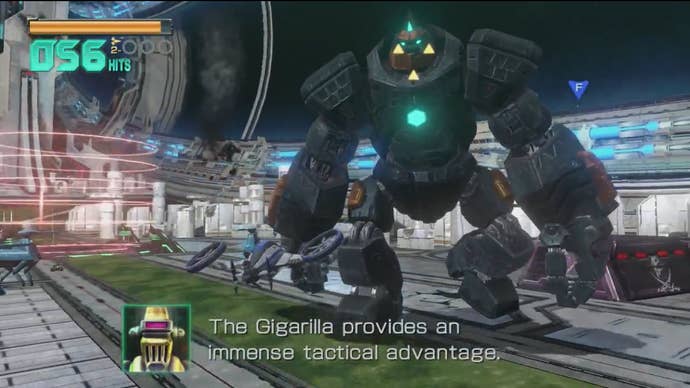
On the Gyrowing
The Gyrocopter was one of the biggest departures for Star Fox Zero - a slower and more deliberate vehicle that starred in what amounted to a stealth level. It was different enough that it was criticized in some quarters for being a little too big of a departure for the series. According to Hashimoto, though, the Gyrowing and its accompanying robot was in the prototype pretty much from the beginning. "[Star Fox] is a game where you can obviously replay stages in different ways, you can take different groups through the main game, and we wanted that feeling of having an adventure and plotting your own course. Also, because there are lots of different planets and lots of different ways of playing them, we hought that having that bonus stage where you fly the Gyrowing would be an interesting change of pace."
In terms of wanting the gyrowing level itself to feel more like an exploration type game; saying that, there's still also shooting elements to the game, or shooting elements to that specific stage. You have the bomb you can pick up and then drop, for example.
Hayashi added, "Yes, I think there's lots of different elements in that stage, being able to pick up that shark and take it around with you. It's definitely something I hoped people would look for - little things like that.
On the common opinion that Star Fox is at its best in the Arwing
A common refrain among Star Fox fans is that the series is at its best when the player is in the Arwing cockpit. I asked for Hayashi's own opinion, and he replied, "Personally, I really like the Landmaster, actually. This time it's actually able to have three lock on shots, so I hope people will try that out and see what they think. And to touch back on the Gyrowing a little bit, you do have that stealth stage on its own; but if you play the game more and are able to find different routes, you are able to play that stage using the Arwing, so hopefully people will try that out as well."
On the decision not to include competitive multiplayer in Star Fox Zero
Competitive multiplayer was a surprise omission from Star Fox Zero. Not surprisingly, the new controls were what caused Platinum and Nintendo to shy away from multiplayer. "I think the main thing we were really focused on, since this did start on that two-screen experiment, is on this being a one-player game. That being said, we did include a co-op mode that you can play locally with the TV and gamepad, where maybe you give the person who feels more comfortable piloting the ship the pro controller, then maybe the less skilled player... maybe the younger player can have the gamepad and enjoy the soothing elements of the game.
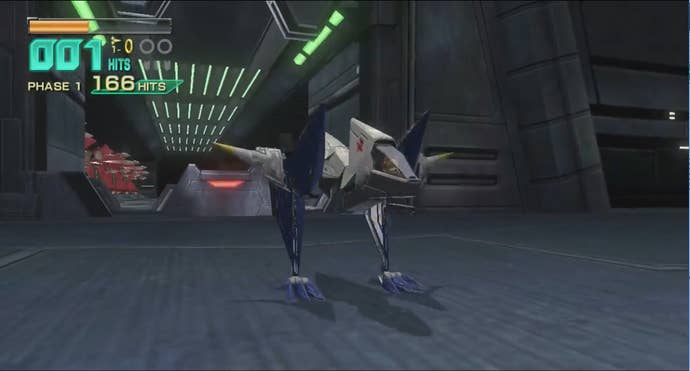
On what they consider to be the best showcase for Star Fox Zero's controls
With Star Fox Zero being something of an experiment in maximizing the Wii U Gamepad, I was curious what the team considered to be the best showcase for the controls in Star Fox Zero. Hayashi replied, "I think for me, it's really the boss on Corneria, which is one of the bosses that uses the target view, where the TV screen has that dynamic cinematic camera and you're dodging the lasers and weaving in between them and you're going in for your attack run. I think, and I've said before, one of the big fun things about a game like this is replaying stages and going for high scores, but one thing that's really fun in a battle like that is really showing off."
Hashimoto agreed that the boss battles that used the dynamic target view were his favorite parts of Star Fox Zero. "You have basically this objective view - this overall view on the TV screen - and then you have this subjective view - the first person view on the gamepad - and it gives a real feeling of presence. I think in this collaboration between Nintendo and PlatinumGames, that was one thing we were really focused on: dynamic situations. And those dynamic boss fights and the views you get in those target view boss fights are something I haven't seen before."
On what Platinum and Nintendo learned from their experiment and whether they would make a more traditional Star Fox game
Hayashi and Hashimoto both repeatedly referred to Star Fox Zero as a kind of experiment. Since experiments are intended to test a particular hypothesis and gain knowledge, I was curious what the team had learned from their experience designing second-screen controls. Hayashi responded. "In terms of what I think we were able to accomplish with the two screens, I think in normal shooting games, you'll always have the camera behind your shoulder - it won't really change. What we were able to do with the two screens is, you have the piloting element of the gameplay, you have that objective screen, the overall screen, and then you have the shooting - the first-person screen on the gamepad that allows you to look around. I think that then makes it a much more dynamic shooting experience, and I think that's the result of the camera system.
Unfortunately for Nintendo, not all critics agreed that the new shooting experience was a net positive. Plenty of reviews complained about how awkward it was shifting from the first-person view to the third-person view across two screens. In that light, I was curious to know if Nintendo would consider developing a Star Fox title with more traditional controls.
Hayashi responded by citing Star Fox's penchant for innovation. "I think with this title, it was definitely something where we looked at the Wii U hardware very specifically and wanted to take advantage of the characteristic of that hardware. And I think if you look at the Star Fox series as a whole, looking back to the Super NES days, through to Star Fox 64, that had the all-range mode and the rumble tech, Star Fox has always been a series that has tried different things, evolving and changing, and I think that will continue. But, for right now, I want to look and see what the reaction [to Star Fox Zero] is. I'm hopeful that people will enjoy the game, but I think for now, we'll just wait and see how things go."


